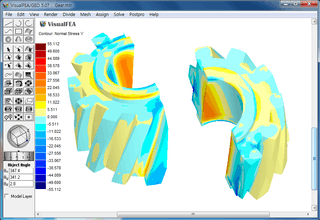VisualFEA
|
| |
|
Screen shot of VisualFEA 5.0 | |
| Developer(s) | Intuition Software |
|---|---|
| Initial release | January 2000 |
| Stable release |
5.11
/ January 18, 2016 |
| Operating system | Windows, Mac OS X |
| Type | Finite element analysis |
| License | Proprietary |
| Website | |
VisualFEA is a finite element analysis program running on MS Windows and Mac OS X platforms. The program is being developed and distributed by Intuition Software, Inc. in South Korea, and is used chiefly for structural and geotechnical analysis. The strongest point of the program is its intuitive and user-friendly usage based on graphical pre- and postprocessing capabilities. VisualFEA has educational functions for teaching and learning structural mechanics and finite element analysis through graphical simulation. Thus, this program is widely used in college courses related to structural mechanics and finite element method.
Overview
VisualFEA is a full-fledged finite element analysis program with many easy-to-use but powerful features, which can be classified largely into four parts: finite element processing, pre-processing, post-processing and educational simulation. All the functions are integrated into a single executable module, which is a characteristic of the program distinguished from other finite element analysis programs generally composed of multiple modules. The whole procedure from pre-processing to analysis, and to post-processing can be completed on the spot without launching one program after another, or without pipelining data from one program to another.
Processing
VisualFEA can solve the following types of problems.
- Mechanical analysis
- Truss, frame, plane stress, plane strain, axisymmetric, plate bending, shell and 3D solid
- Linear, material nonlinear or geometric nonlinear analysis
- Static or dynamic analysis
- Construction staged analysis
- Geotechnical analysis (consolidation, slope stability analysis)
- Heat conduction analysis
- Plane, axisymmetric and 3D volume
- Steady state or transient analysis
- Linear or nonlinear material model
- Fire damage analysis
- Seepage analysis
- Plane, axisymmetric and 3D volume
- Steady state or transient analysis
- Confined or unconfined boundary condition
- Coupled analysis
- Heat conduction coupled mechanical analysis
- Seepage coupled mechanical analysis
Pre-processing
A finite element model in VisualFEA consists of various objects: curve, primitive surface, node, element and mesh. VisualFEA has its own CAD-like capabilities of creating graphical objects without aid of external programs. VisualFEA can create structured or unstructured meshes in two- or three-dimensional space using the following mesh generation schemes.
- Mapping scheme (lofting, tri-mapping, transfinite mapping, isoparametric mapping)
- Sweeping scheme (extrusion, translation, rotation, twisting)
- Auto mesh scheme (triangulation, tetrahedronization)
- Mesh treatment (mesh carving, mesh operation, intersection, distortion)
The program has the function to save the generated mesh data in text format for use by other application programs. Other pre-processing capabilities include the following items.
- Definition and assignment of boundary conditions, material properties and element joints, etc.
- Node number or element number optimization
- Handling of element orientation, local coordinate axes
Post-processing
VisualFEA has various functions of visualizing the numerical data generated by solving the analysis models. The most frequently used graphical representation of the data are the contour and vector images. There are many other forms of graphical representation available in VisualFEA.[1]
- Iso-surface
- Sliced plane, parallel plane, cross plane
- Diagram (bending moment diagram, shear force diagram, etc.)
- Curve plotting
- Data probing
- Animation
Educational Simulation
VisualFEA can be used as a tool for computer-aided education of structural mechanics and finite element method. The tools are operated with the user-created modeling data and their ensuing analysis results on the basis of finite element technology. They are devised to promote the understanding, and to stimulate the interest in the subjects by substantiating the conceptual principles and visually exhibiting the complex computational processes with the aid of interactive computer graphics. The topics covered by the educational functions are as follows.
- Mathematical relationships of internal forces in rigid frames.[2]
- Geometric properties of an arbitrarily defined member section
- Stresses on the member sections
- Moving load
- Mohr circle and its application to elasto-plastic yielding.[3]
- Stress path and yield surface
- Buckling
- Stiffness assembly and solution process in the finite element analysis.[4]
- Shape function and interpolation
- Eigen value analysis. [5]
- Concept of adaptive analysis
VisualFEA/CBT
VisualFEA/CBT is an educational version of the program[6] published by John Wiley and Son's Inc. as a companion program to a textbook[7] on finite element method. The program has the limitation of 3000 nodes that can be handled.
References
- ↑ J.Y.Lee and S-Y.Ahn, Interactive visualization of elasto-plastic behavior through stress paths and yield surfaces in finite element analysis, Finite Elements in Analysis and Design, 47(2011), pp496-510
- ↑ J.Y.Lee and S-Y.Ahn, Finite element implementation for computer-aided education of structural mechanics:Frame analysis, Computer Applications in Engineering Education, 22(2014), pp387-409
- ↑ J.Y.Lee, H.R.Ryu and Y.T.Park, Finite element implementation for computer-aided education of structural mechanics:Mohr's circle and its application, Computer Applications in Engineering Education, 22(2014), pp494-508
- ↑ J.Y.Lee, Interactive simulation of finite element equation processing for educational purposes, Computer Applications in Engineering Education, 23 (2015) pp157-169, DOI 10.1002/cae.21586
- ↑ J.Y.Lee, H.R.Ryu, Interactive simulation of eigenmodes for instruction of finite element behavior, Computer Applications in Engineering Education, 23 (2015) pp872-886, DOI 10.1002/cae.21659
- ↑ R.D.Cook and Intuition Software, VisualFEA and General User Manual, John Wiley and Son's Inc, 2001
- ↑ R.D.Cook, D.S.Malkus, M.E.Plesha, R.J.Witt, Concepts and Applications of Finite Element Analysis, 4th ed., John Wiley and Son's Inc, 2001
